![]()
![]()
![]()
Use LEFT and RIGHT arrow keys to navigate between flashcards;
Use UP and DOWN arrow keys to flip the card;
H to show hint;
A reads text to speech;
46 Cards in this Set
- Front
- Back
|
What nematodes infect cats and dogs?
|
Ascarids (toxocara), hookworms (ancylostoma), threadworms (strongyloides) and heartworm(dirofilaria). Whipworms infect dogs but not cats.
|
|
|
What is the prepatent period?
|
This is the time from the point of infection until a specific diagnostic stage can be identified.
|
|
|
What are the symptoms of Toxocara infection?
|
Diarrhea and weight loss.
|
|
|
How do you diagnose Toxocara?
|
Fecal flotation and direct fecal smear.
|
|
|
Is Toxocara zoonotic?
|
Yes.
|
|
|
What is ELISA?
|
An enzyme-linked immunosorbent assay test used for detecting exposure to roundworms in humans.
|
|
|
How do you treat roundworms (toxocara)?
|
Anthelmintics such as fenbendazole (Panacur), purantel pamoate (Nemex)
|
|
|
What are the symptoms of hookworms (ancylostoma)?
|
Anemia and sometimes, diarrhea with blood and mucus.
|
|
|
How do you diagnose and treat hookworms (ancylstoma)?
|
Fecal exam for eggs. Treat with anthelmintics such as fenbendazole and Ivermectin.
|
|
|
How do you diagnose and treat whipworms in dogs?
|
Fecal exam detects eggs; administer anthelmintics.
|
|
|
What is the prepatent period for whipworms in dogs?
|
Three months - administer prophylactic anthelmintics.
|
|
|
What is the vector for Dirofilaria?
|
Mosquito.
|
|
|
What is the prepatent period for Dirofilaria in dogs?
|
6 months.
|
|
|
How do you diagnose heartworm?
|
If the dog has been infected for 6 mos or more, an antigen with detect heartworm. Cats must be diagnosed by evaluating their history in conjunction with echocardiography, serology, and thoracic radiographs.
|
|
|
How do you treat heartworm in dogs?
|
Melarsomin dihydrochloride give IM in the back; 2 doses in 48 hrs.
|
|
|
How do you treat heartworm in cats?
|
25-50% cats can survive the infection with restricted activity and corticosteroid therapy.
|
|
|
How do you prevent heartworm?
|
Prophylactic drugs are adminstered before and during mosquito season. Ivermectin, milbemycin, and selamectin are used monthly in dogs and cats.
|
|
|
Where do heartworms live in dogs and cats?
|
In the pulmonary artery and right ventricle of the heart.
|
|
|
What is the common tapeworm of dogs and cats?
|
Dipylidium.
|
|
|
What is the intermediate host of the common tapeworm?
|
the flea.
|
|
|
How do you diagnose and treat the common tapeworm?
|
Egg packets or proglottids are found in the feces. Treat with anthelmintics.
|
|
|
Are hydatid tapeworms threats to humans?
|
Yes.
|
|
|
How do you diagnose and treat hydatid tapeworms?
|
Fecal exam finds eggs. Treat with anthelmintics and keep pets from eating raw meat and hunting rodents.
|
|
|
Are dogs and cats hosts for coccidia?
|
Yes
|
|
|
What type of parasite is coccidia?
|
a protozoan.
|
|
|
How do you diagnose and treat coccidia in dogs and cats?
|
Coccidia oocysts are found in the pet's feces. Treat with drugs -sulfadimethoxine and trimethoprim-sulfadiazine
|
|
|
What is a common zoonotic coccidia found in cats?
|
Toxoplasma gondii
|
|
|
How do you diagnose and treat toxoplasmosis in cats?
|
Diagnosis is done via a blood test that measures the antibodies to T. gondii. The antibiotic clindamyacin is the treatment of choice for cats with toxoplasmosis.
|
|
|
What precautions do humans need to take to avoid contracting toxoplasmosis?
|
Do not eat raw meat. Do not allow cats to hunt or eat raw meat. Clean litterboxes daily. Control rodents/
|
|
|
What is giardia?
|
A protozoan that lives in the small intestine of dogs and cats.
|
|
|
What are the symptoms of Giardia?
|
Diarrhea.
|
|
|
How can you prevent your pet from being infected with Giardia?
|
Keep pets from drinking potentially contaminate water (puddles, streams)
|
|
|
How do you diagnose Giardia?
|
The cysts is found in the host's feces by fecal flotation.
|
|
|
How do you treat Giardia?
|
There are two antiprotozoal drugs commonly recommended (metronidazole and quinacrine)
|
|
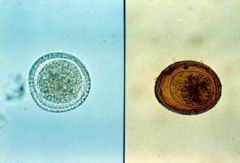
|
On the left is an egg of Toxocara canis On the right is the egg of Toxascaris leonina,
|
|
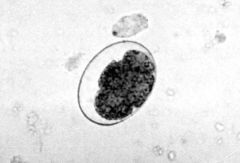
|
This is the egg of the hookworm of dogs and cats (Ancylostoma)
|
|
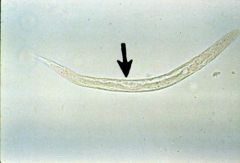
|
This is the first-stage larva of Strongyloides stercoralis, a nematode that lives in the wall of the small
intestine of dogs and cats. |
|
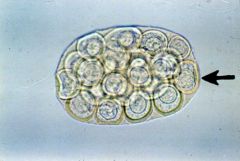
|
The eggs of Dipylidium caninumare distinctive because they are found in packets containing 10 to 30
eggs. |
|
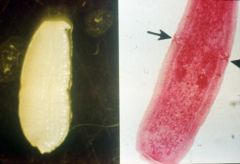
|
These are proglottids of Dipylidium caninum. The proglottid on the left was recovered from the surface
of a stool sample. The white color and the curved sides make this segment resemble a cucumber seed. |
|
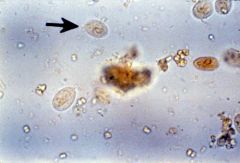
|
These are cysts of Giardia, which are found in both dogs and cats.
|
|
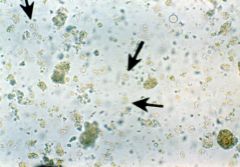
|
This is the oocyst of Toxoplasma gondii, a coccidian parasite of cats.
|
|
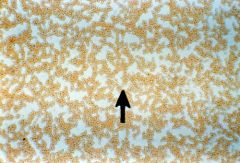
|
The microfilaria of the dog heartworm, D. immitis, can often be seen in a direct smear of the blood of an
infected dog. Although the numerous red blood cells may hide part of the worm, the movement of the microfilaria is easy to see. As seen in this photo of a direct blood smear, the microfilaria is fairly large (300–320 µm long) (arrow). |
|
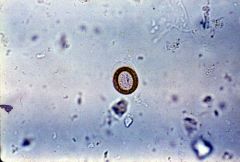
|
The eggs of Taenia taeniaeformis, a tapeworm of the cat, and those of Taenia
sp., Multicepssp., and Echinococcussp., which are found in the dog, all look like this egg. Taenia-type eggs measure about 35 µm wide and have a thick shell that contains striations or stripes. |
|
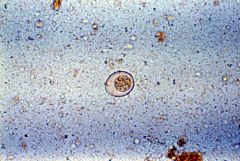
|
This is the oocyst of Isospora canis, a coccidian parasite of dogs.
|
|

|
On the left are two red blood cells infected with Babesia canis(arrow). This organism, which lives inside
the red blood cells of the dog, is very small (1–2 µm). They usually occur in pairs within the red blood cell. On the right are blood cells of a bird, some of which are infected with a protozoan parasite (Haemoproteussp.). All bird red blood cells have a nucleus. |
|
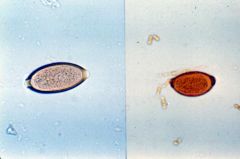
|
There are two different eggs in this photo that look very much alike. The egg on the left is that of the
whipworm of dogs, Trichuris vulpis. It is a symmetrical lemon-shaped egg with a plug at either end. The whipworm egg has a smooth shell and is about 80 µm long. On the right is the egg of the lungworm Capillaria aerophila, which is found in both dogs and cats. This egg is more oval and less symmetrical than that of the whipworm. It is also slightly smaller (65 µm long) and has a rough, pitted shell. It is important to be able to tell these two eggs apart, because the treatment is different for each infection. (40×objective, unstained) |

